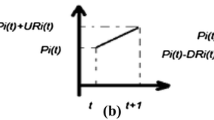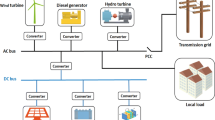Abstract
The optimal operation of micro-grids has attracted the attention of many developed societies considering different objectives, such as the operational cost, pollution rate, and the increasingly extensive use of renewable energy resources in this field. The aggregation of these mostly contradictory goals in an optimization problem can provide an appropriate response for the users of these systems. In this study, in order to manage energy in systems with various micro-grids that differ in quality, we aim to apply the multi-objective particle swarm optimization method to obtain the optimal distribution of energy resources in a sample micro-grid, while simultaneously satisfying economic and pollution related operational objectives.







Similar content being viewed by others
Explore related subjects
Discover the latest articles, news and stories from top researchers in related subjects.Abbreviations
- Ng:
-
The numbers of the energy generation units
- Ns:
-
The numbers of the storage units
- Nk:
-
The total number of load levels present in the grid
- Ui(t):
-
The status of the ith unit at time t
- PGi(t):
-
The amounts of output power for the ith unit at time t
- PSj(t):
-
The amounts of output power for the jth storage unit at time t
- BGi(t):
-
The energy price offer for the ith unit at time t
- Bsj(t):
-
The energy price offer for the jth storage unit at time t
- SGi(t):
-
The startup or shut-down costs for the ith unit at time t
- Ssj(t):
-
The startup or shut-down costs for the jth storage unit at time t
- PGrid(t):
-
The amounts of power exchanged at time t
- BGrid(t):
-
The offered market at time t
- EGi(t):
-
The amounts of pollution attributable to the ith generation unit at time t
- Esj(t):
-
The amounts of pollution attributable to the jth storage unit at time t
- EGrid(t):
-
The amounts of pollution attributable to the market at time t
- SOCsj(t):
-
The charging amounts of a storage unit at the current times
- SOCsj(t-1):
-
The charging amounts of a storage unit at the previous times
- Pchg/Dchg(t):
-
The charging (discharging) amount during the tth hour
- PCDSimax:
-
The maximum charging (discharging)rate
- DG:
-
Distribution generation
- SFLA:
-
Shuffle Forge leaping algorithm
- MINLP:
-
Mixed integer nonlinear programming
- OPF:
-
Optimal power flow
- PSO:
-
Particle swarm optimization
- MOPSO:
-
Multi-objective particle swarm optimization
References
An Z, Zhounian L, Peng W, Linlin C, Dazhuan W (2015) Multi-objective optimization of a low specific speed centrifugal pump using an evolutionary algorithm. Eng Optim 48(7):1–24
Barklund E, Pogaku N, Prodanović M, Hernandez-Aramburo C, Green TC (2008) Energy management in autonomous microgrid using stability-constrained droop control of inverters. IEEE Trans Power Electron 23(5):2346–2352
Chaouachi A, Kamel RM, Andoulsi R, Nagasaka K (2013) Multiobjective intelligent energy management for a microgrid. IEEE Trans Industr Electron 60(4):1688–1699
Chen C, Duan S, Cai T, Liu B, Hu G (2011) Smart energy management system for optimal microgrid economic operation. IET Renew Power Gener 5(3):258–267
Coello CA, Lechuga MS eds (2002) MOPSO: a proposal for multiple objective particle swarm optimization. In: Proceedings of the 2002 IEEE Congress on Evolutionary Computation, CEC’02
Di Silvestre ML, Graditi G, Sanseverino ER (2014) A generalized framework for optimal sizing of distributed energy resources in micro-grids using an indicator-based swarm approach. IEEE Trans Industr Inf 10(1):152–162
Dovžan D, Logar V, Skrjanc I (2015) Implementation of an evolving fuzzy model (eFuMo) in a monitoring system for a waste-water treatment process. IEEE Trans Fuzzy Syst 23(5):1761–1776
Kennedy J (2011) Particle swarm optimization. Encyclopedia of machine learning. Springer, Berlin, pp 760–766
Lughofer E (2013) On-line assurance of interpretability criteria in evolving fuzzy systems—achievements, new concepts and open issues. Inf Sci 251:22–46
Marzband M, Ghadimi M, Sumper A, Domínguez-García JL (2014) Experimental validation of a real-time energy management system using multi-period gravitational search algorithm for microgrids in islanded mode. Appl Energy 128:164–174
Moghaddam AA, Seifi A, Niknam T (2012) Multi-operation management of a typical micro-grids using particle swarm optimization: a comparative study. Renew Sustain Energy Rev 16(2):1268–1281
Moradi MH, Eskandari M, Hosseinian SM (2015) Operational strategy optimization in an optimal sized smart microgrid. IEEE Trans Smart Grid 6(3):1087–1095
Muthuswamy R, Krishnan M, Subramanian K, Subramanian B (2015) Environmental and economic power dispatch of thermal generators using modified NSGA-II algorithm. Int Trans Electr Energy Syst 25(8):1552–1569
Narimani MR, Joo J-Y, Crow M (2017) Multi-objective dynamic economic dispatch with demand side management of residential loads and electric vehicles. Energies 10(5):624
Nikmehr N, Ravadanegh SN (2015) Optimal power dispatch of multi-microgrids at future smart distribution grids. IEEE Trans Smart Grid 6(4):1648–1657
Niknam T, rasoul Narimani M, Jabbari M, Malekpour AR (2011) A modified shuffle frog leaping algorithm for multi-objective optimal power flow. Energy 36(11):6420–6432
Parvizimosaed M, Farmani F, Anvari-Moghaddam A (2013) Optimal energy management of a micro-grid with renewable energy resources and demand response. J Renew Sustain Energy 5(5):053148
Precup RE, Filip HI, Radac MB, Petriu EM, Preitl S (2014) Online identification of evolving Takagi-Sugeno-Kang fuzzy models for crane systems. Appl Soft Comput 24:1155–1163
Shuai Z, Sun Y, Shen ZJ, Tian W, Tu C, Li Y et al (2016) Microgrid stability: classification and a review. Renew Sustain Energy Rev 58:167–179
Taheri B, Aghajani G, Sedaghat M (2017) Economic dispatch in a power system considering environmental pollution using a multi-objective particle swarm optimization algorithm based on the Pareto criterion and fuzzy logic. Int J Energy Environ Eng 8:99–107
Wu LZ, Hao XH (eds) (2014) Multi-objective operation optimization of a micro-grid using modified honey bee mating optimization algorithm. Applied Mechanics and Materials, Trans Tech Publ
Xie J, Zhong J, Li Z, Gan D (2011) Environmental-economic unit commitment using mixed-integer linear programming. Eur Trans Electr Power 21(1):772–786
Xuebin L (2009) Study of multi-objective optimization and multi-attribute decision-making for dynamic economic emission dispatch. Electr Power Compon Syst 37(10):1133–1148
Author information
Authors and Affiliations
Corresponding author
Rights and permissions
About this article
Cite this article
Aghajani, G., Yousefi, N. Multi-objective optimal operation in a micro-grid considering economic and environmental goals. Evolving Systems 10, 239–248 (2019). https://doi.org/10.1007/s12530-018-9219-y
Received:
Accepted:
Published:
Issue Date:
DOI: https://doi.org/10.1007/s12530-018-9219-y




